风道方向对器件测量的影响
日期:2012-06-19
The Effect of Wind Tunnel Orientation on Component Measurements |
|
The thermal performance of an electronic component is sometimes measured by mounting it on a board in a wind tunnel and testing it at a variety of air flow rates. Although at higher speeds, forced convection will clearly dominate, as the air speeds get lower, the effect of buoyancy will become more and more significant. Since wind tunnels are made in both horizontal and vertical configurations, the question is:
Here are two very simple little FLOTHERM analyses to look into that question. The configurations that have been examined are:
In each case, existing validated FLOTHERM models have been used to save time.
The first analysis used a 208L PQFP (Plastic Quad Flat Pack) mounted on a low conductivity test board (equivalent to the JEDEC Standard JESD 51_3 board) in a wind tunnel. This is the same general arrangement as has been shown elsewhere in these Web pages, and has also been discussed in detail at a number of conferences.
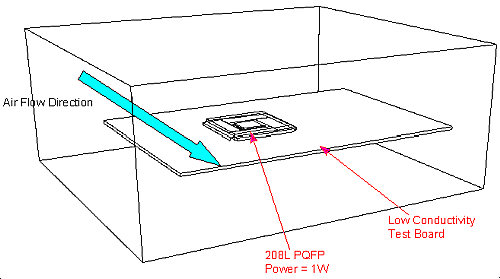
Figure 1-1: The 208L PQFP in the Wind Tunnel
Here are a typical set of results for the component:
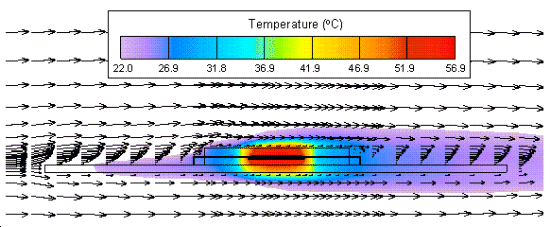
Figure 1-2: Typical Results (208L PQFP; Power=1W; Air Speed=1m/s)
Here are all the results: 1W Horizontal 1W Vertical H-V U(fpm) U(m/s) Tmax Thja Tmax Thja Diff. 0 0.0 62.6 42.6 61.0 41.0 3.7% 20 0.1 60.9 40.9 60.1 40.1 2.1% 99 0.5 56.9 36.9 56.8 36.8 0.3% 197 1.0 54.5 34.5 54.5 34.5 0.1% 394 2.0 ---- ---- ---- ---- ---- 591 3.0 ---- ---- ---- ---- ---- 2W Horizontal 2W Vertical H-V U(fpm) U(m/s) Tmax Thja Tmax Thja Diff. 0 0.0 ---- ---- ---- ---- ---- 20 0.1 100.3 40.2 98.1 39.0 2.8% 99 0.5 93.2 36.6 92.8 36.4 0.6% 197 1.0 88.6 34.3 88.5 34.2 0.2% 394 2.0 83.3 31.6 83.2 31.6 0.0% 591 3.0 80.6 30.3 80.6 30.3 0.0% 1W Horizontal (JEDEC Still Air Test) U(fpm) U(m/s) Tmax Thja 0 0.0 61.6 41.6 Table 1-1: Summary of the Results for the 208L PQFP Tmax = Junction Temperature (°C); Thja = Theta(ja) (°C/W)
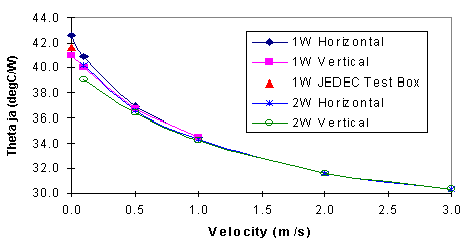
Above 1m/s, it's clear that the orientation of the tunnel is having little effect on the Theta(ja) results measured. However, below 1m/s, the results diverge, depending on both tunnel orientation and the power of the component. CPGA + Heatsink Tests In the second analysis, the PQFP was replaced with a cavity-down CPGA (in this case, using the FLOTHERM model of the 66MHz PentiumTM CPGA package supplied with the standard installation) and a heatsink. Whilst the majority of the heat from the PQFP in the previous example enters the board (see the analysis of the PQFP heat flux budget), for the CPGA, the majority of the heat will pass to the air through the heatsink. The two cases might therefore therefore represent different ends of the spectrum of components that could be tested in this way.
Figure 2-1: The CPGA+HS in the Wind Tunnel
Figure 2-2: Typical Results (CPGA+HS; Power=16W; Air Speed=1m/s) 16W Horizontal 16W Vertical H-V U(fpm) U(m/s) Tmax Thja Tmax Thja Diff 0 0.0 ---- ---- ---- ---- ---- 20 0.1 108.8 5.6 102.0 5.1 7.6% 99 0.5 84.5 4.0 82.6 3.9 3.0% 197 1.0 72.1 3.3 71.8 3.2 0.5% 591 3.0 62.6 2.7 62.6 2.7 0.0% 985 5.0 60.5 2.5 60.5 2.5 0.0% Table 2-1: Summary of the Results for the CPGA+HS Tmax = Junction Temperature (°C); Thja = Theta(ja) (°C/W)
Figure 2-3: Summary of the Results for the CPGA+HS
Interestingly, although the thermal behavior of this component is very different to the PQFP (the majority of the heat being passed to the air through the heatsink rather than through the board), the results are remarkably similar. Once again, above 1m/s the orientation of the tunnel has little effect on the results and below 1m/s the results for the horizontal and vertical tunnel configurations diverge. Author: Steve Addison |








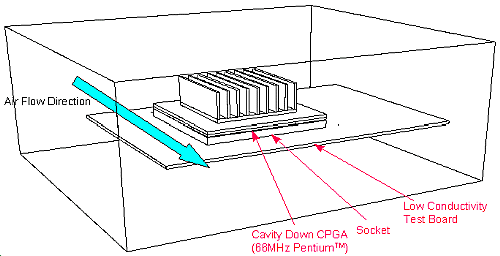
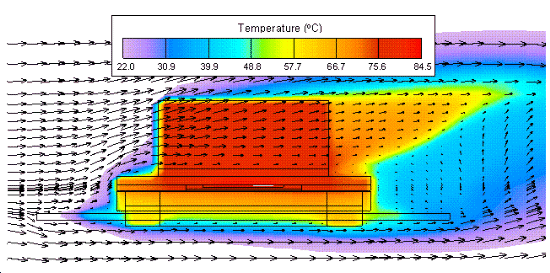
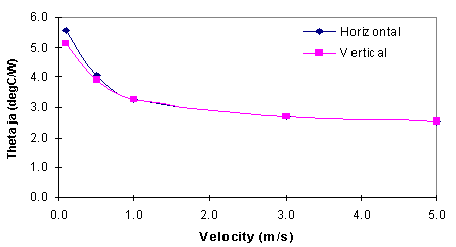

 沪公网安备 31010602003953号
沪公网安备 31010602003953号